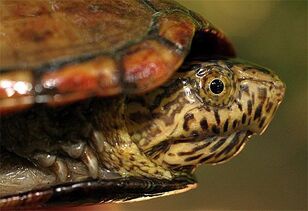
Mud Turtles are fun, medio-easy to keep, and very active. Muds live in warm, wet southern states, including Texas and Florida. They make good beggining pets for novice herpetoculturists, but even make good pets for the experienced person. There are many varieties of Muds, and most of them are available through commercial breeding. 
Care[]
Anatomy[]
Mud Turtle's skin is a light yellowish color and their shells are usually black to dark brown. They are about can range from about 4 inches to 1 foot long when they mature, depending on the species. They have small, barely noticeable tails that can be used for sexing (Longer, more visible tail: Male. Shorter, pulled in tail: Female). They have claws on webbed feet for swimming around in their marshy habitats.
Habitat[]
Mud Turtles require a semi-aquatic habitat, about 20-30 gallons of tank space, with some kind of basking light. It will need to be cleaned out about monthly, as algea develops in the water. For land area, you can usually use just a simple little basking platform (Corner Cave Basking Platform). If you want to take it up a notch, you can usually use a glass divider (or acrylic or plastic for that matter), positioned into the tank with aquarium silicone. Then you just pour your substrate into one side an add some steps leading to it. Then you just fill in the other side with water and... presto! You have a coll looking tank. If you want to kick it up even farther, you can do something totally naturalistic. My mud turtle lives in a 20 gallon (long version) aquarium with rocks and pebbles thrown in on one end to make a slight slope, with a filter secretly desguised as a waterfall with water dropping down to a little river amde out of flat stones. All complete with a Zilla basking platform that helps the Muddie get his proper vitamin D and heat. I went totally all out realistic, while providing a land mark that he's known for the whole four years that I've had him. Wild-caught turtles acn benefit from this hugely, seeing the naturalistic display can calm them down and reduce stress and escape efforts, and also provides onlookers with amazement. Another technique in housing mud turtles is in a community vivarium. This is a difficult and expensive task, but comes in handy when housing many herps. You would need a GIANT vivarium, about 40-100 gallons large. You would then need to see what herps match the needs of your mud turtle closely. For example, if Garter Snakes eat goldfish, and mud turtles eat goldfish, they might be able to live together.
Food and Water[]
Mud Tutles, depending on their species, eat anything from goldfish to formulated turtle sticks. They spend most of their time swimming around and cooling off in shallow water. When feeding goldfish, make sure to ask for feeder fish, not commercial pets. Make sure you get about 15-20; they get eaten fast, really fast. When getting formulated food, get whichever suits your turtles needs more.When it comes to water, remember this: your turtle poops and urinates in the water that it drinks. You will need a strong filter that can clean the water that comes through. You will need to change and clean the filter every month or so.